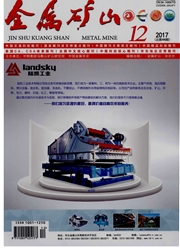

 中文摘要:
中文摘要:
针对已驯化的碱性细菌对铜尾矿进行单纯的生物浸出时铜浸出率不是很高的问题,通过添加适量的氨水进行生物—化学联合浸出试验,并与不添加菌的氨浸这一单纯的化学浸出试验进行对比,来寻求合适的尾矿浸出方式。试验结果表明,在单纯的氨浸试验中,当氨水增加至较高浓度后,铜浸出率增长缓慢;在联合浸出试验中,当初始氨水的浓度40 g/L,浸出时间30 d左右,可达到较好的浸矿效果,铜浸出率可达35.57%。而单纯的碱性细菌浸矿时的最高浸出率为24.51%,同等条件下单纯的氨水浸出时的浸出率仅11.98%,联合浸出率分别提高了11.06个百分点和23.59个百分点。由此可见,低浓度的氨水对细菌浸矿有促进作用。
 英文摘要:
英文摘要:
In view of low copper bioleaching rate of acclimatized alkaline bacteria on copper tailings, biochemical leaching tests by adding appropriate amount of ammonia are carried out, which are compared with the results of single chemical leaching tests to find out the right way for tailings leaching. The results show that in pure ammonia leaching test, copper leaching grows slowly with the ammonia increased to a higher concentration; In the combining leaching tests, a higher copper leaching rate of 35.57% can be achieved when the initial concentration of ammonia is 40g / L within about 30 d; The single alkaline bioleaching can reach maximum leaching rate of 24.51%; Under the same conditions, the leaching rate with single ammonia is only 11.98%; And the combining leaching rates are increased by 11.06% and 23.59% respectively. It can be seen that low concentration of ammonia can promote the bacteria leaching.
 同期刊论文项目
同期刊论文项目
 同项目期刊论文
同项目期刊论文
 Investigation on the threshold control of safety blasting vibration velocity for the extraction of c
Investigation on the threshold control of safety blasting vibration velocity for the extraction of c The effect of solid components on the rheological and mechanical properties of cemented paste backfi
The effect of solid components on the rheological and mechanical properties of cemented paste backfi Leptospirillum forms a minor portion of the population in Zijinshan commercial non-aeration copper b
Leptospirillum forms a minor portion of the population in Zijinshan commercial non-aeration copper b Comparison of the electrochemical mechanism of chalcopyrite dissolution in the absence or presence o
Comparison of the electrochemical mechanism of chalcopyrite dissolution in the absence or presence o 期刊信息
期刊信息
